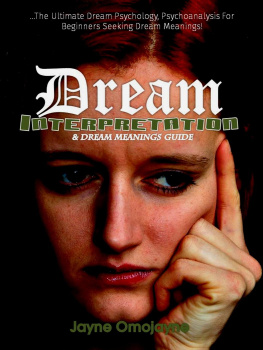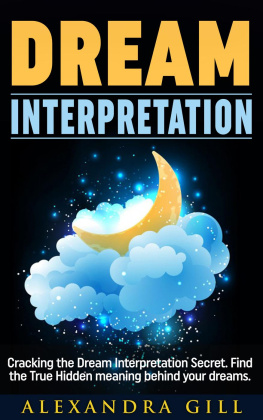STERLING ETHOS and the distinctive Sterling logo are registered trademarks of Sterling Publishing Co., Inc.
All rights reserved. No part of this publication may be reproduced, stored in a retrieval system, or transmitted in any form or by any means (including electronic, mechanical, photocopying, recording, or otherwise) without prior written permission from the publisher.
For information about custom editions, special sales, and premium and corporate purchases, please contact Sterling Special Sales at 800-805-5489 or specialsales@sterlingpublishing.com.
INTRODUCTION AND ACKNOWLEDGMENTS
First, a giant thanks to my family, who have always been my hearts first support team. And next, a heartfelt thank-you to the many dear friends who share my journey on the mystic path.
I dedicate this book both to those who are new to exploring their dreams and to those already on the daily dream adventure. Based on a lifetime of dream analysis, this book shares enough gems of insight to please one and all.
I cannot imagine living life without dream guidance, and thank all who came before me, who paved the way to self-understanding through dreams, starting with Carl Jung. Though I never met Jung, his seminal writing about dreaming continues to inspire. When I once asked a critical question about dreaming, he appeared as himself in a dream to answer my question. I felt greatly honored and cheered, as if he had passed the baton to me and to the many others who attempt to light the way. Many thanks to each of my former teachers at Atlantic University and to all who seek to explain the meaning of dreams.
Speaking of early influences, a great deal of my early understanding about dreams emerged by reading the twenty four published volumes of the Edgar Cayce readings that are available from the Association of Research and Enlightenment, in Virginia Beach. Cayce was a modern day mystic pioneer. He reportedly received his insightswhile giving his psychic readingsby tapping into the Akashic Records, a source of information theorized to be a compilation of the mystical understanding of life. The readings of Edgar Cayce are rich with references to dreams and their importance on the spiritual journey.
In my personal exploration of dreams, for years I kept condensing my dream analysis approach and it eventually evolved into the Five-Step Dream Technique described in this book. As a pivotal thought, I was first exposed to the idea of focusing on a theme or story line (step two of the Five-Step Dream Technique) by famed author Elsie Sechrist, who long ago wrote, Dreams: Your Magic Mirror. Elsie, who I had the privilege of knowing before she passed on, first alluded to generalizing the gist of a dream story at a seminar I attended. The thought has been refined and amalgamated into a quick and easy dream analysis method, proclaimed by newbies and those already on the journey as a great, fast-track tool.
Last but not least, I thank my terrific agent, Lisa Hagan of Paraview Books, a woman of great heart and brain power, and my editor, Kate Zimmermann, who wields a killer eye and pen in weeding out the contents riffraff. Kudos to their incredible work and support.
As the journey continues, it brings to mind some of my favorite lines of poetry. As Lord Alfred Tennyson wrote, I am a part of all that I have met, yet all experience is an arc where thru gleams that untraveled road whose margin fades, forever and forever when I move. May your trek of exploring your dream messages be as exciting as mine.

1

WHAT
IS A
DREAM?
How Author Stase Michaels Arrived at a Definition of a Dream. When you have a dream, your first inclination is to wonder what it means. Few ask, What is a dream? and even as a dream expert, I did the same. For years, I focused on what the dream meant and never questioned what it was. From sleep lab studies, we know about Rapid Eye Movement (REM) sleep, brain wave activity during sleep, and sleep stages. However, such facts do not explain the origins or the function of a dream. Mystics, on the other hand, spoke of dreams as a message from the soul. That may be true, but again, does not define the mechanics of how a dream comes about. It finally dawned on me that I had no clear conception of what a dream really is.
My curiosity led me on a ten year trek to find the answer. I read books and explored scientific journals. These helped me see what a dream does, but not what it is. The closest link to an answer emerged from Freuds day residue idea which looks at dreams as leftovers about daily concerns, a concept later expanded by Montague Ullman. Dreams as day residue became the seed thought that led to a true definition. Mobilizing a lifetime of observations about dreams, a picture slowly unfolded about the mechanics of how a dream comes to be and what it is. As the pot of gold at the end of the rainbow, here is the ultimate definition of a dream, the one that satisfied.
WHERE DREAMS COME FROM
YOU JUGGLE TWO LIVES. You live two lives: an outer life of actions and an inner, hidden life of emotions and thoughts. These inner and outer parts of you are mediated by the psyche, which, in the context of dreams, is defined here as your total interactions between your mind, your body, and for believers, your soul.
YOUR OUTER LIFE. As you go about your day, you carry out your roles as a parent, sibling, friend, student, doctor, bus driver, teacher, social worker, etc. Each role defines what you do, but does not define who or what you are.
YOUR INNER LIFE. While engulfed in daily routines, your mind conducts a silent, ongoing and internal dialogue as it matches up your immediate experience with what you think and feel. These inner-to-outer matchups may leave you feeling conflicted or feeling at peace. So many matchups get tacked on to your silent background bulletin board, that these memories of your daily experience pile up, and, like a stack of papers, they will eventually need to be sorted and filed.
THE PSYCHE AS A SILENT PARTNER. So much of your experience takes place during this silent, inner dialogue. Because this inner dialogue is a private conversation with yourself, ninety percent of what you think and feel remains unshared, even with your best friend or spouse.

















 1
1 